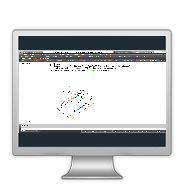

- #APPLIKATION AUF BRICSCAD SOFTWARE#
- #APPLIKATION AUF BRICSCAD CODE#
- #APPLIKATION AUF BRICSCAD LICENSE#
How long the software will keep working is another matter, depending as it does on factors not entirely within your control.
#APPLIKATION AUF BRICSCAD LICENSE#
Assuming you’re a perpetual license holder, when you drop the maintenance contract on one of your AutoCAD licenses, you’re entitled to keep using the software as long as you wish, albeit only the current release at the time the contract ends. So it doesn’t matter that much which AutoCAD release you have hanging around. It means if you’re a power user, CAD Manager, developer or support person, you’re probably going to have to keep one working copy of AutoCAD around even after you’ve completed the transition to BricsCAD.īecause VLIDE has been in maintenance mode for over 15 years it remains virtually unchanged year after year (including ancient bugs). There are various programming editors around that can help with editing code, but no substitute for integrated debugging. There is a downside to BricsCAD’s LISP, and it’s a big one no VLIDE. Upshot: if you’re doing work where there’s a lot of LISP processing going on, switching to BricsCAD is going to save you a shedload of time. That’s 2.88 times faster, which is consistent with my previous observations with a variety of routines. Over half an hour saved on one operation. AutoCAD took 2970 seconds (about 49 minutes), BricsCAD 1030 seconds (about 17 minutes). I ran it on both AutoCAD 2017 and BricsCAD V17 on the same PC. User impressions are one thing, but how about measurements? Today, I had a support job to do that involved running one of my LISP routines. Fast enough to extract the following comment from one of my AutoCAD users trying out a linework cleanup routine in BricsCAD:
#APPLIKATION AUF BRICSCAD CODE#
It’s immediately noticeable when running any LISP code that needs to do a bit of processing that it just gets done faster in BricsCAD than AutoCAD. Reporting LISP bugs and incompatibilities to Bricsys generally gets them fixed super-quick.Īlso super-quick is the speed at which your code will run. It’s often possible to work around these and still retain the same code that works in both AutoCAD and BricsCAD.

There are minor incompatibilities, system variable and command-line differences that cause problems in a handful of cases. It’s a quite astonishingly high level of compatibility.īut it’s not 100%. Some DOSLib functions are built in and the rest can be loaded, as with AutoCAD. Yes, even on the Mac and Linux platforms. It’s not just simple old AutoLISP code that runs in BricsCAD, but complex dialog routines that use DCL, and Visual LISP stuff that uses ActiveX. That’s not an statement that can be made about various Autodesk products that bear the AutoCAD name, such as AutoCAD 360, AutoCAD LT and AutoCAD for Mac. If you’re a power user or CAD Manager transitioning from AutoCAD to BricsCAD, one of the things you’ll like is that almost all of your LISP routines will just work.


 0 kommentar(er)
0 kommentar(er)
